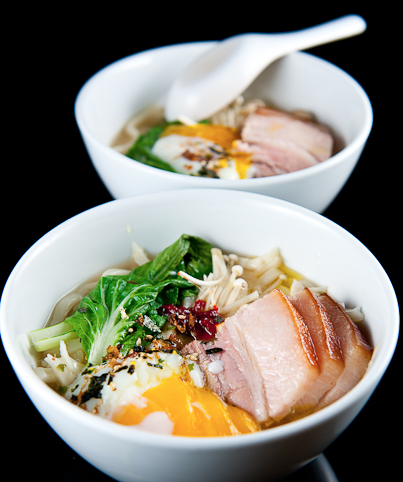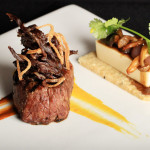Did a walk through today with Ed Vasao, Tuffy Stone and the chef Chris. You are going to love this place when it open in June/July.
Category Archives: Basic Technique
Sous vide Duck Breast
Ingredients
6 Duck breasts, separated and trimmed
2 oranges
2 Blood oranges
¼ cup triple sec or other orange liquor
Salt and pepper
- peel the skin off of the oranges with as little pith as possible.
- juice the oranges and reduce to about half and add the triple sec, cool.
- score fat on duck breast, sprinkle with salt and pepper and place three breast halves in a vacuum bag, add ¼ of the orange skin reduced juice.
- Vacuum seal
- Sousvide at 130F for 2-hours
- Remove breasts from the vacuum bag, reserving the cooking juice, and pat dry. Over medium heat place the breasts in a hot pan breast side down to render the fat and crisp the skin, flip the breast to color the other side. Let rest.
- The juices can be used as a sauce, add some chicken stock and reduce, I like to add a little orange juice concentrate. Slice and serve.
Udon with 36-hour Pork Belly
Courtesy of Stephane Lemagnen (zencancook.com)
Serves 6

INGREDIENTS
For the sous vide pork belly
- 2 pounds (0.9 kg) pork belly, skin on
- 1/4 cup (60 ml) kosher salt
- 1 teaspoon (5 ml) coriander seeds, coarsely ground
- 1 teaspoon (5 ml) star anise, coarsely ground
- 1 teaspoon (5 ml) cardamom, coarsely ground
- 1 teaspoon (5 ml) black pepper, coarsely ground
- 1/2 stick cinnamon, coarsely ground
- 1/4 cup (60 ml) sake
- 1/4 cup (60 ml) mirin
- 1/4 cup (60 ml) soy sauce
For the dashi (udon broth) Continue reading
Half Cooked Eggs with Ramen
| Chef/Owner Ivan Orkin |
| Ivan Ramen – New York, N.Y., USA |
| Yield: 6 servings | |
| Menu Price: $2.00; Food Cost/Serving: 50% | |
| Sake | 500 ml |
| Mirin | 50 ml |
| Soy sauce | 200 ml |
| Sugar | 30 g |
| Garlic, coarsely chopped | 40 g |
| Ginger, coarsely chopped | 75 g |
| Eggs, large, room temperature | 6 each |
| Water | 1 ltr |
| Ramen soup (see note) | 1680 ml |
| Scallions, finely sliced | as needed |
| Instructions: | |
| 1. Simmer sake and mirin in a saucepan over medium-high heat for 2 minutes. Reduce heat to low, add soy sauce, sugar, garlic and ginger and simmer and stir for 10 minutes. Cool to room temperature and then refrigerate (see note). | |
| 2. Bring a large pot of water to a boil. Poke a small hole in bottom (larger end) of each egg with a pushpin. Gently slide eggs into boiling water and then start a timer, stirring for first 2 minutes. Remove eggs after a total of 6 minutes and 10 seconds and shock in an ice bath, stirring until there are no pockets of hot water. | |
| 3. In a large bowl, combine shoyu tare mixture with water. When eggs are cooled completely, about 15 minutes later, peel and soak them in shoyu tare liquid refrigerated for at least 2 hours or up to 3 days. | |
| 4. To serve, bring eggs to room temperature and then slice in half with a taut nylon fishing line, lay on hot ramen soup and serve immediately garnished with a pile of sliced scallions. | |
| Notes: | |
| To make ramen soup, combine 1 kilo whole chicken (giblets removed) with 2 liters cold water. Bring to a boil and then turn down to a steady simmer. Skim off foam or fat that rises to surface and every 20 minutes replace any water that has evaporated, keeping water level same. Simmer for 6 hours, then strain and discard chicken solids. Cool and reserve any chicken fat. For each bowl, combine 130 ml hot chicken soup, 130 ml hotdashi and 20 ml of reserved melted chicken fat. Adjust seasoning with Japanese sea salt or soy sauce and then add cooked ramen noodles when serving immediately. Soup can be refrigerated up to 1 week without ramen noodles. | |
Peruvian Inspired Filet Mignon with a Japanese Twist
 Filet mignon with Peruvian chili pepper sauces, Asian BBQ jerky, modernist smoked Gouda custard over onion cracker, onion gel and tea-smoked beech mushrooms. You’ll be applying various techniques: gelification with iota and kappa carrageenan, sous vide, dehydration and smoking with tea.
Filet mignon with Peruvian chili pepper sauces, Asian BBQ jerky, modernist smoked Gouda custard over onion cracker, onion gel and tea-smoked beech mushrooms. You’ll be applying various techniques: gelification with iota and kappa carrageenan, sous vide, dehydration and smoking with tea.
Peruvian Inspired Filet Mignon with a Japanese Twist.
Cooking Word of the Day
Black japonica rice
Rice is the staple food of over half the world’s population. Black Japonica is a combination of Asian black short-grain rice and medium-grain mahogany rice that were grown together in the same field. It is available in well-stocked food stores, gourmet shops, and through mail order. When cooked it provides a nutty mushroom flavor coupled with a subtle, sweet spiciness and juicy texture that goes well as a side dish, in rice salads, casseroles, as a stuffing for turkey or bell peppers, or in stir-fried foods. It also combines well with other rices. Its dark color turns the cooking water a purplish brown. Black Japonica rice is full in natural vitamins, minerals and fiber and is very healthy ingredient.
Cooking Black japonica rice
- 1 cup black japonica rice
- 2 cups water or broth
- 1 tablespoon butter
Directions
- Combine in rice-cooker; takes about 50 minutes to cook.
- Alternately place in pot, cover with tight sitting lid, bring to boil, simmer on low 50 minutes or until all water is absorbed.
- Butter may be omitted.
Cooking Word of the Day
Sauce vierge (French; in English: literally, “virgin sauce”) is a French sauce made from olive oil, lemon juice, chopped tomato and chopped basil.
Frequently, crushed coriander seed is added, and variations may include the addition of other herbs such as chervil, chives, parsley, etc. The ingredients are combined and allowed toinfuse or macerate (depending whether heat is applied or not) in the oil to create the sauce.
The sauce is usually served with shellfish, delicately flavoured white-fleshed fish such as cod, sole, etc.; it is sometimes served over pasta.
The sauce was popularised in the 1980s by Michel Guérard, a French chef, author, one of the founders of nouvelle cuisine, and the inventor of cuisine minceur, from Eugénie-les-Bains, Aquitaine, in south-western France; the sauce has since become a modern classic.
In its original form, the sauce was intended as a Mediterranean preparation and contained a lot of garlic. It was served either hot or cold after infusing the herbs in the oil.
Cooking Word of the Day
Bagna càuda, (from the Piedmontese “hot dip”, alternatively written bagna caôda or bagnacauda, etymologically related to Italian root bagn-, meaning “wet”) is a warm dip typical of Piedmont, Italy, but with numerous local variations. The dish, which is served and consumed in a manner similar to fondue, is made with garlic, anchovies, olive oil,butter, and in some parts of the region cream. In the past walnut or hazelnut oil would have been used. Sometimes, truffles are used in versions around Alba. The dish is eaten by dipping raw, boiled or roasted vegetables, especially cardoon, carrot, peppers, fennel, celery, cauliflower, artichokes, and onions. It is traditionally eaten during the autumn and winter months and must be served hot, as the name suggests. Originally, in Piedmont, the Bagna càuda was placed in a big pan (peila) in the center of the table for communal sharing. Now, it is usually served in individual pots (the fojòt, a type of fondue pot traditionally made of terra cotta).
Can also be as simple as garlic, olive oil, anchovy and lemon zest.
Turnips and Cabbage
Inspired by my refrigerator and a desire to avoid a trip to the market on a cold weekend night while my wife Pat was in New Mexico.
1/2 lb. Slab Bacon, cut in ½-inch dice (Thick cut bacon can be substituted)
1 large Onions, sliced
2 large Turnips, white, cut in ¾-inch dice
1/2 Cabbage, cut ¾ inch chunks
2 Garlic, chopped finely
½ – 1 cup Chicken stock
1/4 cup Vinegar
1/4 cup Sugar
Hot sauce to taste ( I prefer Sriracha)
Salt
Pepper
Place bacon in a casserole pan over medium heat until fat begins to render, add the sliced onions and sauté until soft. Add the turnips, season with salt and pepper, and sauté for 2-3 minutes. Add the garlic and sauté for another 1-2 minutes, add the cabbage, stock, enough to create stem, vinegar, sugar and hot sauce. Cover and cook to desired tenderness. Add more salt and pepper to taste.
Serve. Using a slotted spoon, to leave excess liquid behind.
